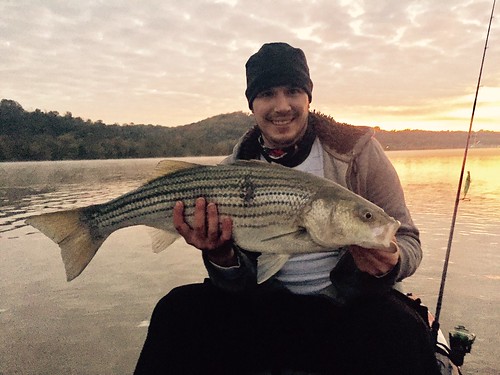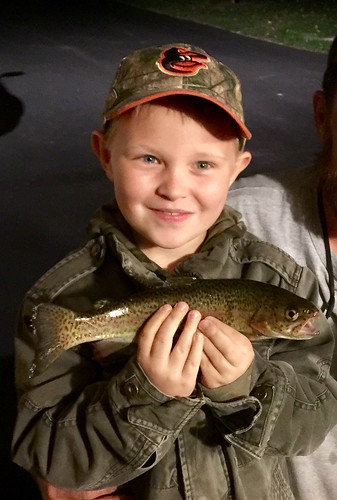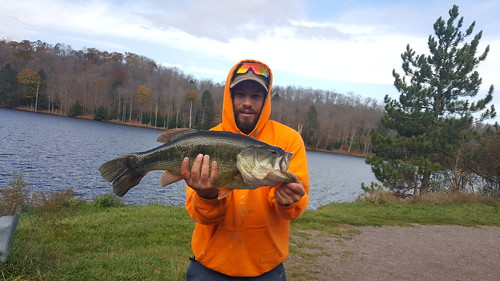By: Keith Lockwood
Welcome to November. All connected to the outdoors, be they fish, animal or outdoorsman, will feel the change as the winter months begin to be sensed like a soft and distant sound that will only get louder as it gets closer. Do not miss out on the fantastic fishing opportunities in the next month before they fade as the winter months approach.
The very upper portion of the Chesapeake Bay near the mouth of the Susquehanna and south past Pooles Island has been experiencing stained water due to runoff coming down the Susquehanna lately. The Conowingo Dam has been releasing water on a daily basis about mid-day. Water temperatures in the upper bay are about 58° this week. The fishing has been good for striped bass in the lower Susquehanna and surrounding areas near the flats and the mouth of the Elk River. Josh Smith holds up a nice Susquehanna Striped bass he caught recently.

photo by Don Goff
There has been plenty of good striped bass action to be found along main channel edges such as Brewerton Channel and the main shipping channel. Jigging has been one of the more productive methods when birds can be spotted or suspended fish can be located on a depth finder. Trolling has also been a good way to fish when heavy inline weights are used to get bucktails and spoons down deep to where the fish are holding.
White perch in the upper bay are also holding deep in the channels near the mouths of the tidal rivers and the bay. Most are using bottom rigs baited with pieces of bloodworm or jigs. Channel catfish and yellow perch can also be part of the mix. At the Bay Bridge, white perch are holding near the rock piles and some of the bridge piers.
Near the Bay Bridge and south to the middle bay region striped bass are spread out over a wide area. Most of the legal-sized fish are holding deep along channel edges or in the channels. One of the better ways to locate them is to watch depth finders near these areas and then jig metal or soft plastics. Slicks are a good thing to look for and also jigging deep near smaller surface feeding striped bass, which are often marked by diving sea gulls. The main shipping channel and the channels leading out of the mouths of the region's main tidal rivers are excellent places to explore. Those that are jigging in these areas are also finding a mix of sea trout and large white perch. Dennis Jester Jr. was out jigging with his father and they enjoyed catching some nice fish such as this 31" fish.

photo by Dennis Jester Jr.
Shore bound anglers have been enjoying some good fishing opportunities for striped bass and white perch at some of the fishing piers within the region that offer access to deeper waters and the Kent Narrows offers good fishing from the bulkheads. Casting jigs on an angle up current and jigging as the current sweeps a bucktail along is usually a good bet. Crankbaits and jerkbaits can also be a good choice where the current is not strong at prominent point and jetties and bloodworms or cut bait works well on bottom rigs.
Water temperatures in the middle bay region are dipping below the 60° mark and salinities are relatively high at 17 p.p.t. this week. A few of the best fishing reports have been coming from the mouth of Eastern Bay, the False Channel area at the mouth of the Choptank, the mouths of the West River and Little Shoptalk.
In the lower bay region there is plenty of good fishing opportunities this week for a mix of striped bass, sea trout and white perch. The better striped bass fishing has been taking place in the lower Potomac and Patuxent Rivers over active oyster bottom. The Middle Grounds has been holding a lot of striped bass and sea trout as well as the Cover Point and Point-No-Point areas. The mouths of the Nanticoke, Wicomico and Pocomoke Rivers are offering good fishing for striped bass, sea trout and white perch. Most are jigging over suspended fish near the channel edges for this mix. Trolling is another good option when striped bass are the primary target. Bucktails dressed with twister tails, spoons and surge tube lures are all good choices to be pulled behind heavy inline weights. The striped bass are holding deep so it takes some weight to get down to them.
If white perch are your primary target; they can be found in about 50' of water holding over oyster bottom in most of the major tidal rivers. Bloodworms on a bottom rig or small jigs or flies rigged over a sinker will get you down to the perch. Small jigs and flies tipped with a piece of bloodworm often tend to be more enticing to the perch.
Some have not given up on getting out for one more bushel of large and heavy crabs this week. The crabs are in about 15' of water and despite much cooler temperatures well worth the effort, so think of bundling up and give it a go. Trotlines work well and collapsible traps have the added bonus of working any time of the day. Marissa Nimon and Joe Bandy traveled all the way from New Mexico to enjoy some crabbing on the Chesapeake recently with family.

Photo by Rich Watts
Water temperatures in the many freshwater streams, rivers, lakes and ponds continue to drop and in most waters temperatures are somewhere in the 50's. In the western region of Maryland, rivers and streams are running extremely low and clear due to lack of rain. The upper Potomac is very low with water temperatures around 52°. Grass has been breaking up due to cooler water conditions and falling leaves will now add to line fouling. Tubes, grubs and whacky rigged stick worms cast with light line from a distance have been good tactics for these water conditions. Submerged ledges and large submerged boulder areas tend to be good targets when fishing this variety of lures. Trout fishermen taking advantage of the fall trout stocking program are enjoying wonderful fishing conditions despite low water levels. In many trout management waters stocking crews have altered normal stocking locations to place trout in some of the deeper pool areas to insure their long term survival and availability to trout fishermen over a longer period of time. Light lines and stealthy approaches are proven tactics under these conditions whether using bait or small spinners, spoons or flies. Ryan Bishop got to go trout fishing with his dad at Middle Creek and is all smiles with this trout that he caught.

Photo by David Bishop
Deep Creek Lake water levels are down due to draw downs and with water temperatures around 57° fish are very active. Largemouth and smallmouth bass, yellow perch and northern pike are all actively feeding and with boat traffic down to a minimum; this is a wonderful time of the year to fish Deep Creek Lake. Most of the floating docks have been hauled out so natural structure such as grass beds, rocky points and fallen treetops are all good places to target.
Fishing for largemouth bass is usually always good this time of the year due to cooler water temperatures pushing bass to actively feed and put on as much bulk as they can for the coming winter. The shallow topwater bite in the mornings is not something to be missed and right now with our fall daylight savings time adjustment still off till Sunday it is easier to be out on the water before sunrise. Cooler water temperatures do extend the morning topwater bite now that we're into a fall pattern of fish behavior and chain pickerel, northern pike, northern snakeheads and smallmouth bass will be part of the mix depending on where you are fishing. Transition areas that have structure such as sunken wood, rocks or grass are great places to target with spinnerbaits, crankbaits, jerkbaits or various rig situations with soft plastics and stick baits. In tidal waters working the outside edges of grass beds or spatterdock fields on a falling tide is always a good bet.
As water temperatures drop in the shallower areas and grass beds begin to diminish; crawfish will start migrating to deeper water and looking for a place to hunker down for the winter. When this begins largemouth and smallmouth bass will be on the prowl to catch them out in the open so jigs, craws and crankbaits are good choices to get in on this action. David Halbritter Jr. caught and released this whopper size largemouth bass at Piney Run Reservoir in Garrett County recently.

Photo courtesy of Denzil Halbritter Jr.
At the Ocean City area fall is certainly in the air and water temperatures approach the 60° mark. Summer flounder are moving out of the coastal bay areas through the channels leading to the inlet and moving offshore. This is a wonderful time of the year to get in on the action and unfortunately is missed by many who have not experienced it. Large baits are often the ticket for the largest flounder. Gulp baits, live spot if you can find them or finger mullet are all good choices. The inlet and Route 50 Bridge area is where it is happening this week when it comes to fishing for striped bass, tautog, flounder and black drum. The South Jetty is a go to location if you're in a boat but the nearby bulkheads and Route 50 Bridge offer good opportunities also. Casting bucktails, swim shads or drifting live eels can get you into the striped bass action in the evenings. Tautog and black drum are being caught on sand fleas along the jetties and bulkheads.
Surf casters are picking away at striped bass on cut bait and small bluefish on finger mullet. Fishing with bloodworms, clams or sand fleas can get one in on some black drum action in the area also. Outside the inlet boats fishing the Bass Grounds and the various wreck and reef sites are reporting limit catches of sea bass and flounder by those onboard. Triggerfish and bluefish are also part of the mix coming over the rails.
Boom...Morgan
No comments:
Post a Comment